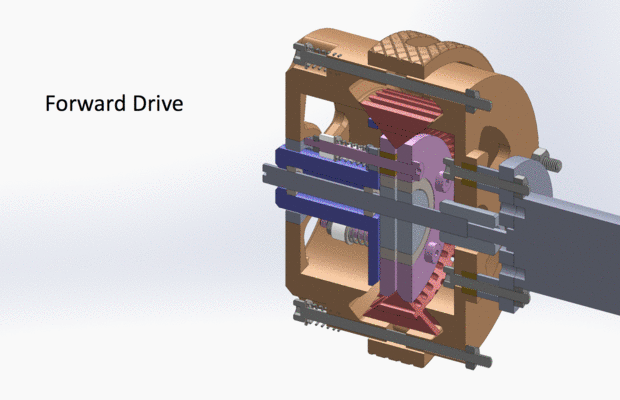


Kernbaum is back with another ingenious—and cleverly named—transmission design. It’s called Inception Drive, and he describes it as “an ultra-compact, infinitely variable transmission based on a novel nested-pulley configuration” that’s designed to make robots—and all kinds of other things—safer, more affordable, and vastly more efficient.
In an infinitely variable transmission (IVT), which is a specific kind of continuously variable transmission, the transmission ratio includes a zero point that can be approached from either a positive side or a negative side. In other words, a constant input, like an electric motor turning the same direction at the same speed, can be converted to an output that’s turning faster, turning slower, turning in the opposite direction, or not turning at all (in this “geared neutral” mode, you’d need infinite input revolutions to cause one output revolution, hence the name “infinitely variable transmission”)
IVTs do already exist: The concept is not brand new. What is brand new from SRI is the clever engineering that makes Inception Drive an order of magnitude smaller and lighter than existing IVTs. This is a big deal because it means that IVTs can be integrated into robotic applications in a way that was physically impossible before.
The reason why a transmission like this is important for robotics is primarily because of the efficiency that it enables, as Kernbaum explains in a paper presented at ICRA earlier this year:
It’s not uncommon for a robotic transmission to be less than 50 percent efficient…. When the output speed changes frequently, it is impossible to optimize a motor and fixed-ratio transmission system for size, performance, and efficiency at the same time: The fixed ratio of the transmission causes substantial losses within the motor. For instance, a high-quality electric motor may be 90 percent efficient when operating under high velocity and low torque, but in robotic applications, the system must instead be designed to achieve the needed peak torques and speeds in the smallest package possible, resulting in a system that almost never operates near its peak efficiency.
A variable-ratio transmission can help align the motor velocity with its peak efficiency or peak power, but their size, weight, and complexity have historically precluded their use in most robotic and industrial applications. This is where SRI’s ultra-compact infinitely variable transmission (IVT) can play a key role. Its small size, simplicity, and reversible output enable several new applications for variable-speed transmissions. It is small enough to replace fixed-ratio transmissions in robots, where we believe it can cut the energy consumption of many robotic platforms in half, doubling battery life for mobile platforms.
There are a few very important things going on here that are very hard to see, because they’re happening inside the drive itself. The first thing is how the two pulleys interact with each other. This happens through the V-belt, of course, but it’s not as though one pulley turns, which turns the belt, which causes the other pulley to turn, as in a conventional transmission. Rather, the outer pulley is fixed and doesn’t turn at all, while the inner pulley, which is nested inside the drive, has a wobble in it, since it’s mounted off-center to the input shaft. (The device’s name is a reference to the movie Inception, but with nested pulleys instead of dreams.)

As the input shaft causes the inner pulley to wobble around in a circular motion, it’s continuously lifting the V-belt off of the outer pulley on its outward wobble, and putting the V-belt back down again when the wobble is inward. If the effective diameters of the inner and outer pulleys are the same, the V-belt will just get transferred back and forth between the two pulleys and not much will happen. But if the effective diameters of the inner and outer pulleys are different, the V-belt will get pulled in one direction or the other as it tries to keep the two pulleys connected. Since the outer pulley doesn’t rotate, the force exerted by the V-belt makes the inner pulley rotate instead, and this is the output of the transmission.
Source: IEEE Spectrum
